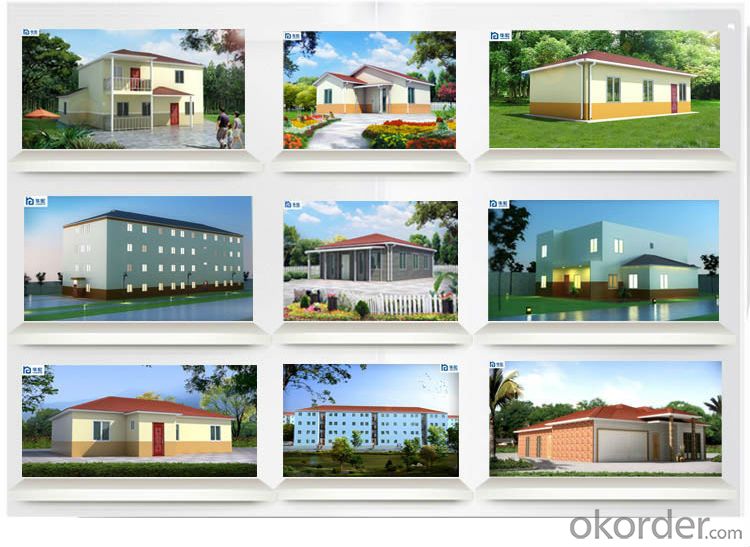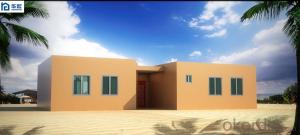Hot sale cement house
- Loading Port:
- China Main Port
- Payment Terms:
- TT OR LC
- Min Order Qty:
- -
- Supply Capability:
- -
OKorder Service Pledge
OKorder Financial Service
You Might Also Like
More questions:
1, What's your Payment term:
30% deposit by TT, 70% balance before loading container by TT; 100% LC at sight(total payment over 100,000USD);
2, How about Shipping:
We use 20 feet container and 40HQ container to ship the goods; Usually one 20 feet container can load about 50-60 square meters' house, 40HQ container can load about 120-140 square meters's house.
3, How to become your agent in our country:
First, you can make a report about your market, include the the rules and laws of prefab house, popular house models, target price, and potential sales quantity.
Second, you must place a trial order to act as the display.
Third, after finishing the sample house and getting the local people's feedback, we will give you the agent right in one area with limited time.
Fourth, Please note that we already have agent in Mumbai City India; Marshall Islands, Trinidad and Tobago.
4, Can you help me to purchase other things like furniture or appliance:
Because the customs law, our company can only export prefab house, so we just can purchase very little matched kitchen and bathroom facilities for you in consideration of customs clearance.
5, Can you send workers to help me build house.
Considering the labor cost, safety and visa issues, we suggest to send one or two engineers to guide and train your staffs. You must provide air tickets, hotel, and meal, and 100USD per day for engineer salary.

- Q:Are container houses suitable for art galleries or exhibition spaces?
- Container houses can indeed be suitable for art galleries or exhibition spaces, depending on the specific needs and vision of the curator or artist. These innovative structures offer several advantages that make them an attractive option for such purposes. Firstly, container houses are highly versatile and customizable. They can be easily modified to create unique and unconventional exhibition spaces, allowing artists to experiment with different layouts and designs. The modular nature of containers also enables easy expansion or downsizing, depending on the size of the exhibition or the number of artworks being displayed. Secondly, container houses are cost-effective. Compared to traditional building materials and methods, containers are relatively inexpensive, making them a budget-friendly choice for artists or gallery owners on a tight budget. This affordability allows for more investment in other aspects of the exhibition, such as artwork acquisition or promotion. Additionally, container houses are portable and movable. They can be easily transported to different locations, providing flexibility for artists who wish to showcase their work in various cities or countries. This mobility also allows for temporary exhibitions in unconventional settings, such as outdoor spaces or remote areas, providing a unique experience for visitors. Furthermore, container houses are environmentally friendly. Recycling shipping containers for exhibition spaces reduces waste and minimizes the carbon footprint associated with construction. This sustainable approach aligns with the increasing demand for eco-friendly practices in the art industry, appealing to environmentally conscious artists, curators, and visitors. However, it is important to consider potential limitations of container houses for art galleries or exhibition spaces. Containers have limited dimensions, which may restrict the size or scale of artworks that can be displayed. Adequate insulation and climate control systems may also be required to ensure the preservation of delicate artworks, especially in extreme weather conditions. In conclusion, container houses can be a suitable and innovative choice for art galleries or exhibition spaces. Their versatility, affordability, portability, and sustainable qualities make them attractive options for artists and curators looking for unconventional and cost-effective solutions. However, careful consideration should be given to specific requirements and limitations to ensure that the container house meets the needs of the artworks and provides a conducive environment for both artists and visitors.
- Q:Are container houses suitable for rental properties?
- Indeed, rental properties can be well-suited for container houses. These houses have become increasingly popular in recent years because of their affordability, sustainability, and versatility. Their design allows for easy transportation, which makes them perfect for rental properties since they can be effortlessly relocated when necessary. One of the primary advantages of using container houses as rental properties is their cost-effectiveness. Compared to traditional housing options, container houses generally offer more affordable prices, allowing landlords to set lower rental rates. This affordability attracts a wider range of tenants, including students, young professionals, and individuals seeking budget-friendly housing options. Moreover, container houses are sustainable and environmentally friendly. They are made from repurposed shipping containers, reducing waste and minimizing the need for new construction materials. Many container houses also incorporate energy-efficient features such as solar panels and rainwater harvesting systems. This sustainability aspect appeals to environmentally conscious tenants, tapping into the growing market of eco-friendly renters. In terms of versatility, container houses can be easily customized and modified to meet different rental requirements. Landlords can adjust the interior layout and design to create multiple living spaces, offering flexibility to cater to diverse tenant needs. Additionally, container houses can be equipped with various amenities like kitchenettes, bathrooms, and heating/cooling systems, ensuring a comfortable living experience for tenants. However, landlords must consider the potential limitations of container houses as rental properties. Since container houses are relatively new in the rental market, there might be a limited number of potential tenants actively seeking container house rentals. Furthermore, the size of container houses may be smaller compared to traditional houses, which may not be suitable for families or individuals in need of more space. In conclusion, container houses can be a viable option for rental properties due to their affordability, sustainability, and versatility. Nevertheless, landlords should carefully assess the specific rental market, target audience, and potential limitations before investing in container houses as rental properties.
- Q:Can container houses be easily transported?
- Yes, container houses can be easily transported. They are specifically designed to be moved and transported using cranes, trucks, or ships. The standardized dimensions of shipping containers make them easy to handle and transport, allowing container houses to be relocated to different locations quickly and efficiently.
- Q:Can container houses be built with multiple stories?
- Yes, container houses can be built with multiple stories. The modular nature of shipping containers allows for easy stacking and creating additional levels. With proper engineering and construction techniques, container houses can be designed and built to accommodate multiple stories, offering greater living space without compromising structural integrity.
- Q:Are container houses customizable in terms of layout and size?
- Container houses offer a great deal of flexibility when it comes to layout and size customization. Thanks to the modular design of shipping containers, they can be readily adjusted to match specific design preferences and necessities. By cutting and eliminating container walls, larger spaces can be created or multiple containers can be joined together to form a more sizable living area. Moreover, container houses can be stacked or arranged in different configurations to suit diverse layouts. This remarkable degree of customization empowers individuals to tailor their container homes to their own distinct requirements and personal tastes.
- Q:Are container houses suitable for healthcare clinics?
- Healthcare clinics can indeed find container houses to be a suitable option. These houses are incredibly versatile, cost-effective, and can be easily modified to meet the specific needs of a healthcare clinic. They can be designed and constructed to include all necessary facilities like waiting areas, consultation rooms, treatment rooms, laboratories, and even surgical units. Container houses come with several advantages for healthcare clinics. Firstly, their portability allows for easy transportation to different locations, making them perfect for temporary clinics or mobile healthcare units. They can be quickly set up without the need for extensive construction work, reducing the time and cost involved in establishing a healthcare facility. Moreover, container houses offer customization options, enabling them to meet specific healthcare standards and regulations. They can be equipped with essential infrastructure like plumbing, electrical systems, and HVAC (heating, ventilation, and air conditioning) to ensure a comfortable and safe environment for both patients and medical staff. Additionally, container houses can be designed in an environmentally friendly manner, incorporating energy-efficient features and sustainable materials. This aligns with the increasing trend towards sustainable healthcare practices and minimizes the clinic's carbon footprint. Furthermore, container houses are durable and resistant to extreme weather conditions, providing a secure and stable environment for healthcare services. They can also be easily expanded to accommodate future growth or changes in the healthcare facility's requirements. In conclusion, container houses offer a suitable option for healthcare clinics due to their versatility, cost-effectiveness, ease of customization, portability, and durability. They provide a viable solution for establishing healthcare facilities in various settings, including remote areas or regions affected by disasters.
- Q:How are container houses constructed?
- Container houses are constructed by repurposing shipping containers, which are typically made of steel and come in standard sizes. The process begins by selecting the desired number of containers and preparing the site where the house will be built. The containers are then cleaned, removing any rust or debris, and modifications are made to create openings for doors, windows, and other necessary features. Next, the containers are positioned and secured to a foundation, which can be a concrete slab or piers, ensuring stability and structural integrity. Once in place, the containers are often reinforced with additional steel beams or welded together to create larger living spaces. Insulation is a crucial step in the construction process, as shipping containers are not naturally insulated. This is done using various materials like foam insulation, spray foam, or fiberglass insulation to regulate the temperature inside the house and prevent condensation. After insulation, the interior walls, flooring, and ceiling are installed to transform the containers into livable spaces. Depending on the design, plumbing and electrical systems are then installed, connecting the house to utilities like water supply, electricity, and sewage. Finally, the exterior of the container house can be customized with siding, paint, or other finishes to enhance its appearance and protect it from weather conditions. Landscaping and outdoor features can also be added to complete the construction process. Overall, container houses offer a cost-effective and sustainable alternative to traditional construction methods. Their construction process is relatively quick and efficient, making them an attractive option for those seeking affordable and eco-friendly housing solutions.
- Q:Can container houses be designed for commercial use?
- Yes, container houses can definitely be designed and used for commercial purposes. Container houses have gained popularity in recent years due to their versatility, affordability, and sustainability. These structures can be modified and customized to suit various commercial needs, such as offices, retail spaces, restaurants, cafes, art studios, and even hotels. Container houses are easily adaptable and can be expanded or combined to create larger spaces. Their modular nature allows for flexibility in design and layout, making them an ideal choice for commercial use. Additionally, container houses can be easily transported to different locations, enabling businesses to move or expand as needed. With proper insulation, ventilation, and interior design, container houses can provide a comfortable and functional environment for commercial activities. They can also be equipped with all the necessary amenities, such as electricity, plumbing, heating, and air conditioning systems. Furthermore, container houses offer cost savings compared to traditional construction methods. They are typically less expensive to build and can be repurposed from used shipping containers, reducing material waste and environmental impact. In conclusion, container houses can be effectively designed and utilized for commercial purposes. They offer a unique and sustainable solution for businesses looking for affordable and flexible spaces.
- Q:Are container houses suitable for healthcare facilities?
- Yes, container houses can be suitable for healthcare facilities. They offer several advantages such as cost-effectiveness, quick construction time, and flexibility in design. Additionally, they can be easily modified and expanded to meet specific healthcare requirements. However, careful consideration should be given to factors like insulation, ventilation, and compliance with regulatory standards to ensure a safe and comfortable environment for patients and medical professionals.
- Q:Can container houses be built with a walk-in closet or storage area?
- Yes, container houses can definitely be built with a walk-in closet or storage area. In fact, one of the advantages of using shipping containers for housing is their versatility and ability to be customized according to individual needs and preferences. While the interior space of a shipping container may be limited, it can still be creatively designed to include a walk-in closet or storage area. This can be achieved by partitioning a section of the container, adding shelves or racks, or installing modular storage units. Additionally, container houses can also be expanded by combining multiple containers to create larger living spaces with ample room for storage. Ultimately, the design possibilities for container houses are endless, and with proper planning and engineering, a walk-in closet or storage area can be incorporated to maximize functionality and organization.
1. Manufacturer Overview |
|
|---|---|
| Location | |
| Year Established | |
| Annual Output Value | |
| Main Markets | |
| Company Certifications | |
2. Manufacturer Certificates |
|
|---|---|
| a) Certification Name | |
| Range | |
| Reference | |
| Validity Period | |
3. Manufacturer Capability |
|
|---|---|
| a)Trade Capacity | |
| Nearest Port | |
| Export Percentage | |
| No.of Employees in Trade Department | |
| Language Spoken: | |
| b)Factory Information | |
| Factory Size: | |
| No. of Production Lines | |
| Contract Manufacturing | |
| Product Price Range | |
Send your message to us
Hot sale cement house
- Loading Port:
- China Main Port
- Payment Terms:
- TT OR LC
- Min Order Qty:
- -
- Supply Capability:
- -
OKorder Service Pledge
OKorder Financial Service
Similar products
New products
Hot products
Hot Searches




























